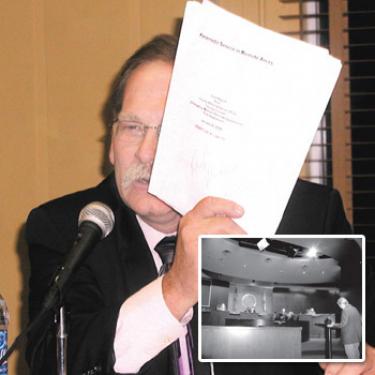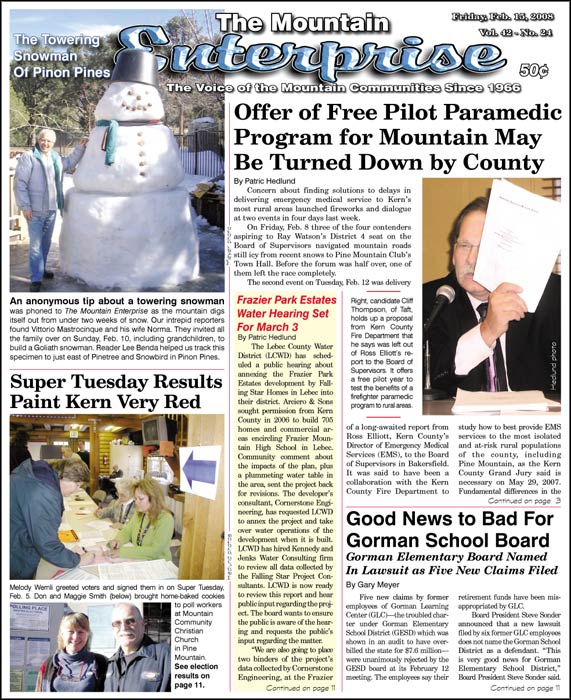
Candidate Cliff Thompson, of Taft, holds up a proposal from Kern County Fire Department that he says was left out of Ross Elliott?s report to the Board of Supervisors. It offers a free pilot year to test the benefits of a firefighter paramedic program to rural areas. Inset, There was a sense of being in a scene from The Wizard of Oz, in which Mountain Community speakers were dwarfed at the podium in the Board of Supervisors? chambers. Here, Karen Bailey speaks about holding her husband as he died, waiting for an ambulance from Taft that took almost an hour to arrive.
By Patric Hedlund
Concern about finding solutions to delays in delivering emergency medical service to Kern’s most rural areas launched fireworks and dialogue at two events in four days last week.
On Friday, Feb. 8 three of the four contenders aspiring to Ray Watson’s District 4 seat on the Board of Supervisors navigated mountain roads still icy from recent snows to Pine Mountain Club’s Town Hall. Before the forum was half over, one of them left the race completely.
The second event on Tuesday, Feb. 12 was delivery of a long-awaited report from Ross Elliott, Kern County’s Director of Emergency Medical Services (EMS), to the Board of Supervisors in Bakersfield. It was said to have been a collaboration with the Kern County Fire Department to study how to best provide EMS services to the most isolated and at-risk rural populations of the county, including Pine Mountain, as the Kern County Grand Jury said is necessary on May 29, 2007. Fundamental differences in the interpretation of available data undermined confidence in the report.
At one point, Elliott indicated that only a small proportion of rural emergency medical calls required advanced life support (ALS) paramedic intervention, compared to 15.7 percent of urban emergency calls. Fire Chief Dennis Thompson said his figures showed that 15.1 percent of rural calls required paramedic assistance.
Kern County Fire Fighters Union President Derek Robinson said that Hall Ambulance Service data shows that 47 percent of the calls in Pine Mountain required ALS intervention during the period studied. "There may be less calls, but the percentage of calls where ALS care is needed seems to far exceed" urban averages, he said.
Robinson said Elliott’s report was "rife with errors, omissions and one-sided statistics," citing a study from Washington state showing that paramedic intervention for some kinds of heart attacks within eight minutes increases patient survival by 32 percent. With ALS delay of 20 minutes, survival decreases to only seven percent. "What that means is that survivability quadruples with early intervention," he said, noting that Elliott’s own study showed that paramedic firefighters could be on scene an average of 25 minutes sooner than ambulance paramedics to rural ares such as Pine Mountain.
Elliott has long expressed his concern that "firefighter paramedics solve only half the problem" in stabilizing the patient. Rapid medical transport to hospital care "within the golden hour" is the important part of the equation that private ambulance services are able to provide, making ambulance paramedic service his preferable option.
However, he also agreed that profitability concerns prevent private companies from providing rapid response service to rural areas. Hall Ambulance Service pulled out of a weekend station in Pine Mountain citing lack of profit in fall of 2007.
In addition, under current ambulance performance standards, when there are icy roads the company can ask for an exemption from their required response time and even fail to respond. On January 24 a Hall Ambulance driver in a four wheel drive automatic chain vehicle said he would not drive beyond the Mil Potrero "Y" to respond to a 911 call in Pine Mountain. It took several hours for Suellyn L’Dera to finally reach a hospital in Bakersfield, after the homeowners association first plowed the county road for the ambulance driver, who still was unable to respond, and then placed the patient in a small four-wheel drive pickup truck to take her to the ambulance.
Supervisors voted to postpone voting on the report for one month, expressing dissatisfaction with the data presented. They asked Elliott to return with "qualitative as well as quantitative information about patient care and outcomes." The need for patient tracking procedures to provide more definitive data was cited. Elliott and ambulance company consultants said that federal patient confidentiality laws (HIPAA) may make it difficult to obtain such data.
Supervisors said other counties had such qualitative tracking. They also indicated concern that EMS data analysis is "half a year behind," current only up to last June. Elliott said loss of personnel in his department was the cause.
Chief Thompson spoke of his department’s proposal to provide a firefighter paramedic pilot program to the three most at-risk rural population concentrations in Kern County. It was proposed that this could be done without additional personnel costs for one year in order to study the efficacy of firefighter paramedics.
Thompson said that Kern County has the 10th largest fire department in the state (out of 600), but is the only department out of the top 15 in the state without a firefighter paramedic program.
County Counsel Steve Schuett said that Proposition 218 may block the county’s ability to accept the Chief’s offer to provide the paramedic service for free. He said he needs to study. the matter.
"Prop. 218 states that you may not place new assessments on property for any service that is already being provided," he said. A pilot program may be considered an "existing service" and therefore make it impossible for the county to charge an assessment for the service at the end of the demonstration project.
Mar Preston and Gita Nelson, both members of the Pine Mountain Club Property Owners Association board of directors, spoke in favor of the community voting to tax itself through Community Service Area (CSA) 40 to achieve better emergency medical service. Supervisors found that an attractive offer and said they would like to help Pine Mountain find a way to pay for its own services.
Supervisors as well as Thompson and Elliott spoke with concern of the $800,000 Elliott said it would cost to initiate a full 12-region paramedic service in Kern county. Thompson said his department is already underfunded for its current mission. Supervisors mentioned state budget cuts and competing county needs.
About 80 people attended the meeting for this issue, almost equally divided between concerned citizens and ambulance company employees.
This is part of the February 15, 2008 online edition of The Mountain Enterprise.
Have an opinion on this matter? We'd like to hear from you.


